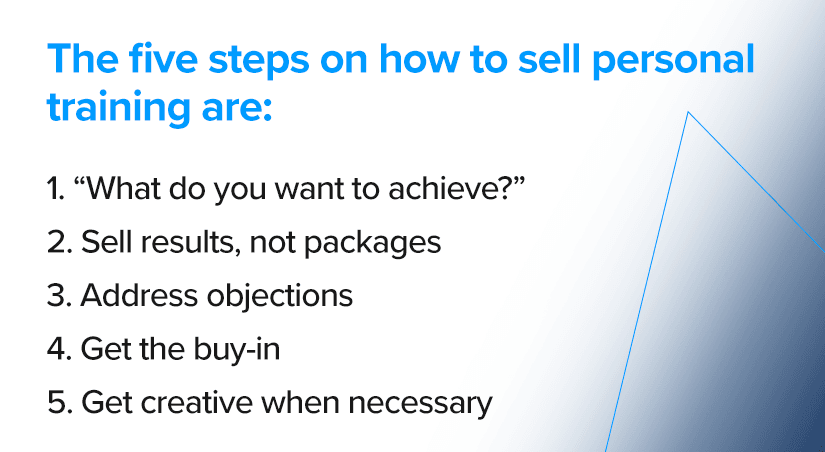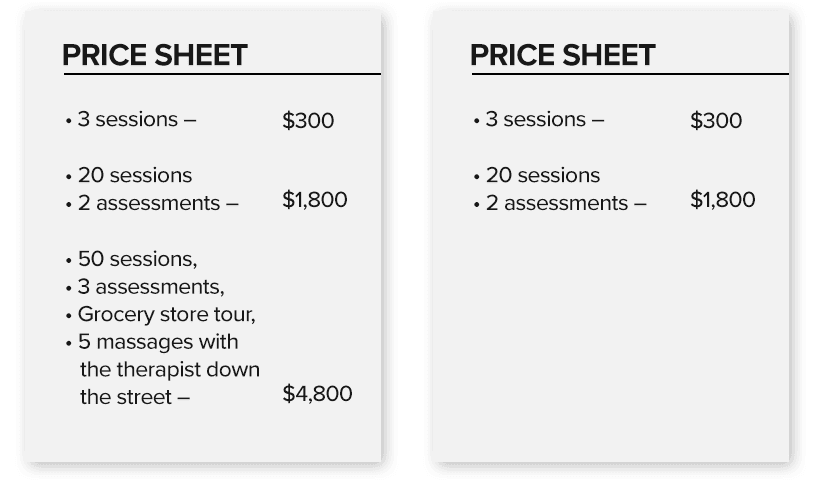The sales process is the hardest part for many personal trainers. To determine how to sell personal training, your skills have to go beyond exercise science. You also need to have business and communication skills.
One thing the pandemic has taught us is that people will always want personal training. That’s the simple part. To get more personal training clients, you also have to convince them you offer the exact services they need.
Consider this all too familiar scenario: You wave goodbye to your previous client and take a long, slow breath, nervous for your next meeting. With a brief stop at the office for some fresh client-intake forms, you put on your happy face: chest up, big smile. You greet the potential client with a firm handshake. The sales meeting has begun.
After the small talk, almost every personal training sales meeting starts with a variation on one of these questions:
- How much does it cost?
- How often do I need to see you?
- What do I need to do to lose X pounds?
- I just want a program to do on my own. Can you do that?
The trick is in the timing. Don’t answer these questions, not yet, at least. It just gets in the way of making your sale or upgrading the client to a more extensive personal training package.
It may seem counterproductive to not answer questions put to you by your personal training client, but you need to have some control over the conversation to make it work to your benefit.
A five-step system for selling your personal training services
During the years I spent working as a personal trainer, I learned five steps you need to follow to give yourself the best chance of signing new clients.
The five steps on how to sell personal training are:
- Ask “What do you want to achieve?”
- Sell results, not packages
- Address objections
- Get the buy-in
- Get creative when necessary

Putting yourself in the driver’s position allows you to do two things:
- Gather information
- Deliver information related to the client’s goals
Personal training requires collaboration. You are not selling this person a service; you are creating a mutually beneficial relationship. Controlling this initial conversation gets you there. Selling doesn’t have to be hard; you just need a pattern to follow—one that begins with you asking one fundamental question.
Step one: Ask “What do you want to achieve?”
The simplest way to take control of the conversation is to ask questions starting with this one, “What do you want to achieve?” Active note-taking assures the client that you care about what they want and take an interest in creating an individualized personal training plan for them.
When the client stops talking, wait in silence for a count of two. Awkward pauses have an uncanny way of opening people up. Given time, most clients will start talking again and perhaps divulge a deeper purpose.
If that awkward pause doesn’t produce the desired effect, ask more questions such as: “Why did you come to see me today?” Pay special attention to emotional reasons, which may help fuel motivation during training. Never forget that emotion drives action.
Keep prodding until you understand what the client wants to achieve and why. To make sure you heard right, paraphrase back to the client their reasons for wanting to train. This assures the client that you’re paying attention and trying to understand their needs. Sometimes all I do during the first meeting with a client is ask questions and paraphrase the answers.
Other questions to ask before moving on:
- Have you been a member of a gym before?
- Have you had a trainer before?
- Why did you quit (or not achieve success) previously?
- Any injuries that keep you from reaching your goals?
- What are your expectations of me?
The more information you collect, the better you can craft a package that offers the perfect solution and make the sale.
Step two: Sell results, not packages
There’s an old marketing adage that says, “Sell benefits, not features.” If you are shopping for a dishwasher, you want to know how it will benefit you. It might be an energy saver, but that feature doesn’t tell you much. It can save you as much as 5 percent off your energy bills, says something.
Once you know what the client wants, you can sketch out a training plan. It doesn’t need to be perfect; you can fine-tune it later. The point is to write it down on paper so the client can see you already have an idea of how to help get results.

Some clients will want more detail than others. Let the client lead.
If they ask about soreness, you can briefly explain how delayed onset muscle soreness works. If they want to know more about your programming methods, share a few of your guiding principles. Stop when it’s clear the client is losing interest. Nobody wants a monologuing trainer.
Let the client know what to expect from your personal training and the benefits. The better the client understands those benefits, the easier it is to sell your personal training services.
Step three: Address objections
Objections are opportunities to close. You want objections when trying to sign new personal training clients. If you miss an objection or fail to adequately address it, you’ll lose the sale.
So be proactive, and say something like, “What do you think about the plan?” The client may say “great” or “good,” raise an objection, or ask a question. Take the time to answer questions about your personal training program or clarify anything unclear.
Flesh out objections
If the client says “good,” ask about obstacles to training to flesh out any more potential issues. Make sure you deal with all objections before asking for the personal training sale. A sales meeting is a series of buy-ins and closing doors. Don’t leave any doors open.
Avoid money talk
Money is often the biggest objection, but try to avoid talking about your personal training prices just yet. If the client asks what you charge for personal training, say that you offer a few packages but aren’t sure which is best.
You might also share your price sheet with the client and say, “Once we figure out what you need, we can land on the best package.” They will feel more at ease, and you’ll have more time to gather the information you need to offer the best solution.
You should also avoid bringing up the price before you’re ready. The cheapest trainer in the world is too expensive if the client isn’t yet sold on your value.
Let the client sell it for you
As the client begins to picture working with you, they may start selling themselves on the idea, finding solutions to their objections. At this point, your job is simple: Shut up. Let the client talk through it.
Some objections you might hear when selling personal training:
- I’m not sure if I have the time for personal training
- I have to think about it
- I think it might be too expensive
- I have to ask my spouse/partner
- I’ve had a bad experience with another trainer
Part of your job is to answer these questions, so plan ahead. For example, you might discuss online personal training with the client worried about time.
Step four: Get the buy-in
Before you talk about your personal training price, book the new client into your schedule. If you get clients to commit to times and dates first, they’ll be less likely to balk at the sale.
In The Art of Choosing, Sheena Iyengar calls this the foot-in-the-door technique. Convince somebody to commit to a smaller decision, and the person is more likely to agree to whatever you propose next—which is the money.
Three-tiered pricing
Remember that personal training sales sheet you handed the client? It should have three options:
- A budget-friendly personal training option
- A middle-of-the-road option
- The premium personal training package with all the bells, whistles, and personal training benefits.
This is pricing theory 101. If you want to sell folks on your middle option, they’re more likely to choose it if it’s sandwiched by the other two.
Compare this price sheet:

Without that third package as a reference point, $1,800 seems like a lot of money, right? But with that option, the middle price seems a lot more reasonable, and many people will choose it. Plus, believe it or not, some people just want the most expensive package. And for those customers, you have a premiere option, just in case.
The A-or-B decision
Of those three options, highlight two—your first and second choices. Always present one as better, but say there’s a second option available. This takes it from a yes-or-no decision to an A-or-B decision.
So you might say something like this:
“Well, Sally, based on what we’ve talked about, I think the best way to achieve your goals is to see me three times a week and work out twice a week on your own, with my guidance.
“The most cost-effective option is the 50-pack of sessions. That’s about four months of training, more than enough time to get measurable results.
“If that’s too big a commitment right now, we also offer a 20-session package. Please also remember that if something comes up and you have to back out, the sessions are fully refundable, no questions asked.”
Offering a guarantee helps reassure the client that you’re a straight shooter and better than other personal trainers. Unfortunately, there are many bad actors in and around the fitness industry.
Step 5: Get creative if necessary
You’ve convinced the client of your value. Good work! All that’s left now is to fill out the paperwork, ask for a credit card, and take payment. It should be that simple.
Unless it’s not.
Sometimes, no matter how well you’ve sold yourself as a personal trainer, the client just can’t afford to see you as often as your plan requires. If that happens, it’s time to get creative.
I had one client, Vlad, who was recovering from rotator cuff surgery and didn’t have much money. Having done physical therapy, he wanted an exercise routine he could do three times a week, focusing on strengthening his shoulder and improving functional strength. He couldn’t afford to train with me that often, but he still wanted a program that changed frequently enough to keep him interested.
We agreed to meet once a week for seven weeks. Vlad’s form was already pretty good, and I was confident he could emulate it the following week if I demonstrated new moves. He also knew that he could contact me with any questions.
I devised a workout plan for him that included seven categories:
- Pull
- Push
- Mid-back/shoulder stability
- Core stability/anti-rotation
- Core rotation/flexion
- Legs (hip dominant)
- Legs (quad dominant)
- Arms
I included four or five exercises in each group and instructed Vlad to choose one or two from each category per workout. Our in-person sessions focused on making Vlad comfortable with the exercises and teaching him how to increase his weight.
By the time we finished, Vlad had a large assortment of workouts that were right for his needs. The exercises were specific, and he knew how to progress. It allowed him to reach his goals while staying within his budget.
He later referred his wife and daughter to me, and they ended up buying over 100 sessions altogether. One creative sales plan led to those essential personal training referrals.
Don’t prejudge your personal training client
Always present the best option to meet your client’s goals, regardless of appearance, age, or anything you may think you know about the person.
I’ve sheepishly presented an older client with the cheapest option, once, only to later discover the client was well off. By then, I’d already set a precedent of training once every two weeks, and switching to multiple weekly sessions was impossible after that.
You are the product. Believe in your value and learn to communicate it to a client. Selling personal training is about confidence. When you master the art of selling your personal training services, you can avoid missing an opportunity to make a sale again.











